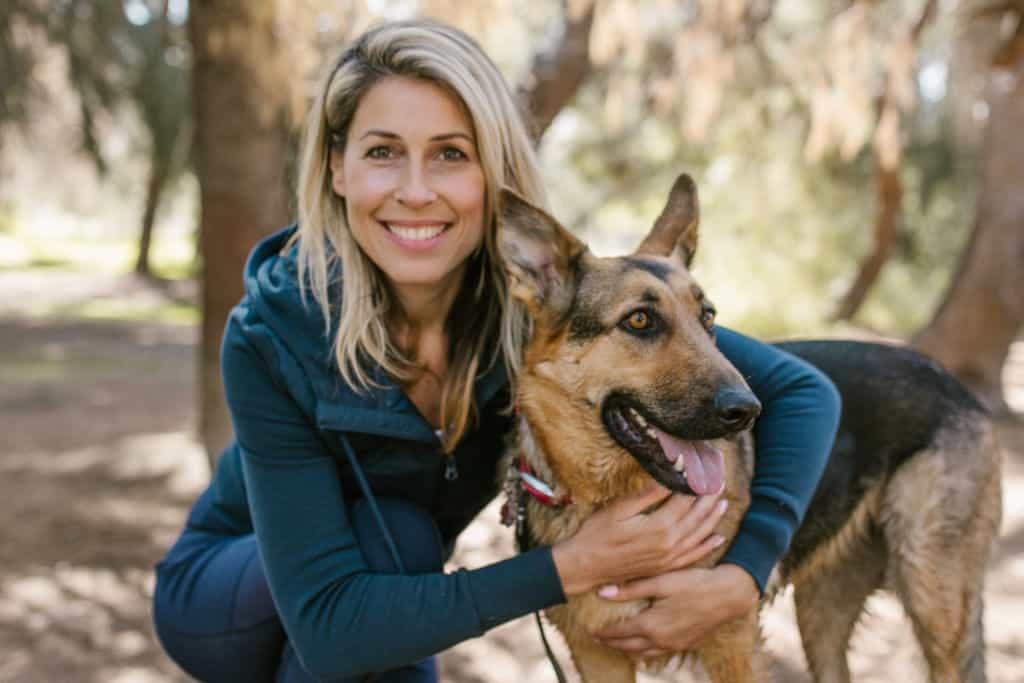Positive reinforcement is a powerful and humane way to train your dog and encourage good behavior.
By rewarding your dog’s positive actions with treats, toys, and praise, you can strengthen the bond between you and your dog while improving their obedience and reducing stress and anxiety.
In this blog post, we’ll show you how to apply positive reinforcement in practice and give you tips and tricks for using this technique effectively. Whether you’re dealing with a new puppy or trying to correct some unwanted behaviors in an older dog, positive reinforcement can be a game-changer.

Quick recap on positive reinforcement
Key points on R+:
- Positive reinforcement: rewarding good behavior
- Builds positive association between behavior and reward
- Use rewards such as treats, toys, praise, or attention
- Choose rewards that motivate your dog
- Timing and consistency are crucial
- Gradual progression to avoid frustration
- Avoid common mistakes (over-reinforcing, reinforcing wrong behavior, inconsistency, inappropriate rewards)
To apply positive reinforcement in practice, you must prepare for training, choose the right rewards for your dog, establish a training plan, and implement positive reinforcement using timing and consistency.
You’ll also need to understand how to avoid common mistakes and gradually progress in training to avoid frustration. We’ll try to keep it simple and easily applicable. So, keep reading to learn more!
Getting Ready for Successful Training
Before you start, it’s essential to lay the groundwork for success. By taking a few crucial steps to prepare, you can ensure that your training sessions are both effective and enjoyable for both you and your dog.
Choose the right rewards for your dog
When choosing rewards for your dog, it’s essential to select those that motivate them. Observe your dog’s behavior and preferences to decide which reward to use.
If your dog is more interested in toys and play, use a toy as a reward for good behavior. If your dog is food-motivated, use treats. And if your dog is highly social and craves attention, praise and attention can be powerful rewards.
Next, consider the value of the reward. For example, if you’re training a new behavior, a higher-value reward like a treat or a favorite toy may be more effective. If you’re reinforcing an already learned behavior, a lower value reward such as verbal praise or a pat on the head may suffice.
But keep in mind your dog’s diet when choosing treats. Ensure the treats you choose are healthy and not overly high in calories or sugar.
Read more: How to Choose Training Toys for Your Dog
Build a Successful Training Plan
Establishing a training plan is crucial to successful positive reinforcement training. Before you begin, you must identify the specific behavior you want to reinforce and set achievable goals.
First, identify the behavior you want to reinforce. Think about what your dog is already good at and build on those skills. For example, if your dog already knows how to sit, you can start training them to stay, lay down, or to come when called.
Once you’ve identified the behavior you want to reinforce, set a clear and specific goal. For example, having your dog sit on command within three seconds when given the verbal cue ‘sit’.” If it’s a more complex command, break it down into short, specific steps.

If you’re just starting to train your pup, consider our step-by-step guide on teaching your dog their name. Easy to use, yet simple and very effective.
Putting Positive Reinforcement into Action
Proper timing and consistency are crucial in applying positive reinforcement.
Timing and consistency are key
For reinforcement to be effective, you must deliver the reward at the right moment and in a consistent manner. Here are some tips on how to achieve this:
- Be Clear and Specific. Before starting any training session, ensure you have a clear and specific goal. This will help you focus on what behavior you want to reinforce and how you want to reinforce it.
- Use a Reward Marker. A marker, such as a clicker or a verbal cue, can signal to your dog that they’ve done something right and that a reward is coming. Timing is critical when using a marker, so use it immediately after your dog performs the desired behavior.
- Reward Consistently. For reinforcement to be effective, the reward must be consistent. This means you should reward your dog every time they perform the desired behavior, at least in the beginning stages of training. This will help your dog learn what behavior is expected of them.
- Stay Positive. Positive reinforcement is about rewarding good behavior, so stay positive and upbeat during training sessions. Dogs are very attuned to their owner’s emotions, so your positive energy can help keep them engaged and motivated.
By following these tips, you can help maintain timing and consistency in reinforcement and ultimately make positive reinforcement training a success for you and your furry friend.
How to use an effective Reward Marker
When used correctly, reward markers can help capture the exact moment when your dog performs the desired behavior, making training faster, more precise, and less frustrating.
By using a consistent sound, such as a click or a word like “Yes!”, you can establish a clear association in your dog’s mind between the behavior, the sound, and the reward.
The use of reward markers can also help you train your dog to perform a wide range of behaviors and tricks, including those that may be difficult to reward in real time. For example, you can use a reward marker to capture and reinforce the exact moment your dog blinks, sticks out his tongue, or prances, and then follow up with a treat or a toy.
When choosing a reward marker, it is important to consider factors such as the sound or signal’s consistency, volume, and ease of use. Popular options include a clicker, a special word, a whistle, or a hand signal.
After marking, quickly give your dog the reward you have chosen. The key is to mark the behavior precisely and quickly, so your dog can connect the behavior and the reward.
Remember always to follow the rules of reward markers:
- mark exactly when the desired behavior occurs,
- reward immediately after marking,
- and don’t reach for the reward until after you’ve marked.
Remember to use the same marker consistently and exclusively for training, and always reward your dog after each click or marker sound.
Consistency and the rate of reinforcement
Here are a few pieces of advice to keep in mind:
- Consistent use of markers and rewards. Use the same markers and rewards every time, and use them similarly for each behavior you’re training.
- Clear communication. Be clear and concise when giving commands. Use a consistent tone of voice and body language, and avoid using too many words or unclear gestures.
- Predictable Schedule. Set a regular training schedule that works for you and your dog, such as setting aside a certain time each day for training or breaking it up into smaller sessions throughout the day.
- Reinforcement Rate. Aim for a rate of at least 10 rewards per minute when teaching a new behavior. A high rate of reinforcement is important to keep your dog engaged, especially in distracting environments.
Training Frequency and Duration
Rather than long and infrequent training sessions, opt for short and frequent sessions. This approach maintains focus and motivation, while frequent reinforcement helps the behavior become a habit.
Aim for several short training sessions a day rather than one or two long ones. For example, if you’re teaching your dog to stay, start with just one or two seconds and gradually increase the duration by a few seconds at a time.
Examples of how to apply positive reinforcement
To help you see what it looks like in practice, here are three examples of positive reinforcement in practice.
Teaching “Sit”.
Full guide to teaching your dog to sit, but here’s the gist of it:
Hold a treat in front of your dog’s nose and slowly move it up and over their head. As their nose follows the treat, their bottom will naturally lower to the ground. When they sit, say “Yes!” or “Good boy/girl!” and give them the treat.
Repeat this a few times, then add in the verbal cue “Sit” as you move the treat. With consistent practice, your dog will learn to associate the cue with the behavior and sit on command.
Loose Leash Walking
We have an easy-to-follow guide on loose leash walking, but here are the basics:
When your dog is walking calmly on a leash, say “Yes!” or “Good boy/girl!” and give them a treat. If they start to pull, simply stop walking and wait for them to come back to you. As soon as they do, reward them with a treat and resume walking.
With practice, your dog will learn that walking calmly by your side leads to rewards, and they will start to do it more often.
Potty Training
Full guide available here, but here’s the gist of it:
Take your puppy outside to their designated potty area every 1-2 hours, as well as after meals, naps, and playtime. When they go potty, say “Yes!” or “Good boy/girl!” and give them a treat.
If they have an accident inside, don’t punish them, but simply clean it up and take them outside to their potty area to reinforce the desired behavior. With consistent positive reinforcement and some proper potty training aids, your puppy will learn where they are supposed to go potty and start doing it on their own.
Taking it step by step
Gradual progression in training is key to avoiding frustration and keeping your dog motivated. You don’t want to overwhelm your dog with too much too soon, or they may become disinterested or frustrated.
Instead, break up the behavior you’re trying to train into small, achievable steps. This will help your dog build confidence and stay motivated as they learn.
For example, if you’re teaching your dog to stay, start with just one or two seconds and gradually increase the duration by a few seconds at a time. Once your dog can stay for 30 seconds or more, you can introduce distractions or increase the distance.
By taking things slowly and gradually, you’ll give your dog a chance to stay calm and master each step before moving on to the next, making the training process more enjoyable and less stressful for you and your dog.
Common Mistakes in Using Positive Reinforcement
Even with positive reinforcement, there are some common mistakes pet owners can make that can hinder its effectiveness. The most common are:
- Rewarding in the wrong amount or at the wrong times. Too many or too few rewards can both be problematic. Find a balance that motivates without overwhelming your pet.
- Reinforcing undesired behavior. Accidentally rewarding unwanted behavior can send mixed messages. Be sure to reward only the behaviors you want to encourage.
- Being inconsistent– Consistent use of markers and rewards is crucial for effective training.
- Choosing ineffective rewards– Not all rewards are created equal. Find what motivates your dog, whether it’s treats, toys, or praise.
To learn more about these mistakes and how to avoid them, check out our in-depth guides on basic obedience and trick training.
Wrapping up
Congratulations on taking this step to effectively train your dog using positive reinforcement. Stay positive, keep it simple, and enjoy your journey with your furry friend. With patience and practice, you’ll soon see the positive results of your efforts.
FAQs
Alex, a passionate animal lover, has experience in training and understanding animal behavior. As a proud pet parent to two dogs and three cats, he founded AnimalReport.net to share insights from animal experts and expand his knowledge of the animal kingdom.




